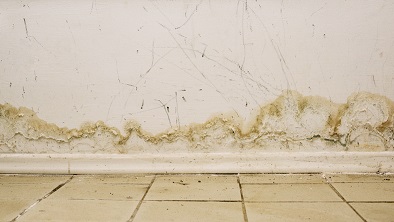Warning Signs of Mold After Flooding
As the rate of hurricanes and severe thunderstorms increases, so does the threat of flooding. Unfortunately, once the water and debris from a flood have been cleared, there’s often another danger afoot: mold.
Despite their tiny size, mold spores can wreak havoc on the human body when they’re inhaled or consumed. Dealing with a flood in your home is traumatic enough, but a full-fledged mold infestation can create long-term problems!

Combating the Outbreak
Generally speaking, it takes between 24 and 48 hours for mold to develop on a surface. Thus, after a flood, it’s absolutely critical that you act quickly to prevent a major issue. Here are some tips for keeping mold at bay:
Let the Sunshine In
Opening doors and windows can help with the drying process, provided that (1) it’s not currently raining outside, and (2) the relative humidity in the space that you’re trying to dry out is higher than the relative humidity outside. If possible, leave doors and windows open during the daylight hours and close them at nighttime for at least a few days.

Break Out The Big Guns
While a few towels might be adequate for wiping up a small puddle, floods require more advanced tools. Use fans, water pumps, and/or wet-dry vacuums to remove moisture from surfaces as best as you can. And once the majority of the water has been removed, dehumidifiers can help with what remains.
Remove Wet Items
Boxes, furniture, odds and ends that you threw in the basement while telling yourself that you’d “deal with them later”—it’s all got to go somewhere else for the time being!
Storing things outside is ideal, but your garage can work, too, provided that there’s adequate ventilation. The idea is to get these items into a space where they can dry without further exposure to the water-logged environment.
Get Cleaning
Hard, nonporous items made of materials like metal, glass, and plastic can usually be cleaned. Use a commercially-prepared cleaning liquid made specifically for destroying mold and mildew, or prepare a solution of 1 cup bleach with 1 gallon of water.
Machine-washable clothing can sometimes be salvaged, as well—wash the load with bleach (or a non-bleach laundry sanitizer) and dry everything immediately.
Discard Unsanitized Items
Unfortunately, certain materials are nearly impossible to clean adequately once they’ve succumbed to flood damage, which means that keeping them in your home may just undo all of your mold-prevention efforts.
Wooden furniture, upholstered furniture, wallpaper, drywall, ceiling tiles, and insulation are all vulnerable, as are products made of leather and paper. While it’s sometimes possible to salvage carpeting and carpet padding, these floor coverings usually need to be ripped up and replaced completely.
The Dangers of Mold
The following illnesses have all been linked to mold exposure:
- Gastrointestinal distress (IBS, nausea, diarrhea, stomach cramps, etc.)
- Joint pain and weakness
- Chronic allergy symptoms (including sinusitis and sneezing) and asthma
- Headaches (including migraines) and brain lesions
- Chronic fatigue
- Cognitive dysfunction (“brain fog,” slurred speech, confusion)
- Hearing problems
- Rashes, hives, and bloody skin lesions
- Anxiety and depression
If you or anyone in your family starts to exhibit these symptoms after a flood, it may be worth investigating mold as a possible culprit. And if you thoroughly clean and dry a flood-affected area but a damp or “earthy” smell persists, then mold might be the cause—even if you don’t see any patches or spores anywhere in the room.
How RealTime Labs Can Help
At RealTime Laboratories, we offer the following products to take the “guesswork” out of mold problems:
» Urine Testing Kits can be used to detect mycotoxins—that is, harmful substances produced by certain types of fungus that can cause illness in mammals. Our kits require only a small amount of urine to detect up to 15 different types of mycotoxins, making them painless and user-friendly.
» Environmental Mold And Mycotoxin Assessments can test specific areas for 10 kinds of mold AND 15 kinds of mycotoxins using dust samples collected from a heating unit or air conditioner. This test is useful for taking “evasive” action against mold, as you can test the environment before anyone shows signs of illness.
» Phone consultations with medical professionals who can help you interpret the results of your mold tests and give advice for further actions to take. It’s one thing to know that you have a mold infestation in your home or body—knowing how to get rid of it is another matter entirely!
Additionally, a list of reputable, RTL-Certified Mycotoxin Environmental Specialists can be found on our website. This list can serve as a valuable resource when your mold problem is too big to handle on your own—or you’d rather defer to a professional to make absolutely certain that the job gets done right.
Mold can ruin home furnishings and pose serious health hazards to everyone living in the contaminated area. It’s critical, then, to take mold-prevention measures after you experience a flood. So clean up the area, know the signs of mold-related illnesses, and talk to the pros whenever you think that there’s “a fungus among us”—it’s the best way to keep yourself and your family safe.
Have a Question?
Send us your comments and questions and our team of mold experts will answer your questions!
"*" indicates required fields
